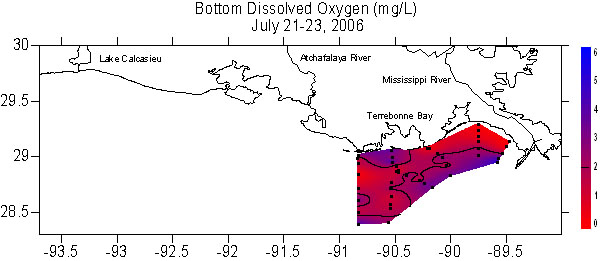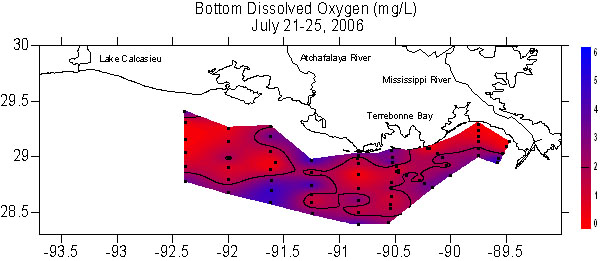[ 2006 | 2007 | 2008 | 2009 | 2010 | 2011 | 2012 | 2013 | 2014 | 2015 | 2016 | 2017 | 2018 | 2019 | 2020 | 2021 | 2022 | 2023 | 2024 | 2025 ]
2006 Shelfwide Cruise: July 20 - July 28
The Issue. The scientific work for the commonly name 'Dead Zone' is hypoxia or low oxygen. The second largest zone of hypoxia in the world's coastal waters is found in the Gulf of Mexico adjacent to the Mississippi River system. Important commercial and recreational fisheries are impacted as reduced oxygen levels force fish, shrimp and crabs from the area. Animals that cannot move away die. Fresh water and nutrients from the Mississippi lead to the annual formation of the hypoxic waters, and increasing nutrient loads beginning in the 1950s are responsible for the worsening oxygen conditions since then.
Daily Log
- 1900 -
- Prep for cruise, Happy Birthday Melissa
- 0010 -
- Depart Cocodrie on R/V Pelican
- 1000 -
- Arrive Southwest Pass, Mississippi River
Calm, hot, isolated thundershowers
- 1300 -
- Complete water sampling in Mississippi River
Collection of salinity gradient/nutrient concentrations
Collection of Miss R end member for methyl mercury study
- 1400 -
- Deploy towed ADCP
- 1500 -
- Begin hydrographic stations on transect A' and on to transect A
Extremely low oxygen levels in bottom waters within the 20- to 25-m isobath
Portunid crabs at water surface over hypoxic bottom waters
High phytoplankton biomass and supersaturated surface waters (>200%)
Mercury methylation box core station
- 2400 -
- Complete 2 box core stations on transect A
- Calm, slight chop, isolated thundershowers
- 0200 -
- Complete box core station on transect A
- 0800 -
- Complete transect A and steam to transect B, LUMCON Fourchon camp on the horizon
- 1800 -
- Complete transect B
Hypoxic bottom-waters from 5 to 30 m depth
Seas reaching to 2 ft, occasional 3 ft, 9 to 15 kn winds SSW, slowed speed for towed ADCP
Several super tankers at the LOOP (Louisiana Offshore Oil Port) facility
- 1900 -
- Begin transect C
Spinner sharks!!! Juvenile flying fish!!!
Series of box cores at multiple stations on transect C for microphytobenthos
Portunid crabs at the water surface over bottom water with low oxygen.
- 0100 -
- Tow for bulk plankton mercury and methyl mercury determination
- 0300 -
- Station C6C, site of moored instruments. No diving. Night dives are for the Caribbean, not Gulf of Mexico oil platforms.
- 0800 -
- Winds 15 kn SSW, choppy
- 0900 -
- Complete box core series for transect C
- 1100 -
- Return to C6C to dive and exchange oxygen meter. Frontal passage and squalls as we prepared to dive. Winds 15 kn from the north and building seas. Aborted.
- 1200 -
- Begin transect D'
- 1930 -
- Finish transect D' and head west to southern end of transect D.
Extensive hypoxia along transect D' to a depth of 35+ m. Value in 42 m was < 3 mg/L. Most of the afternoon in transit was spent outrunning the front as we headed south finishing the station before the frontal margin reached us. Winds 12-15 kn from the SSW then the SSE.
- 2100 -
- Begin transect D, complete box coring at D3
Continued low oxygen along this transect.
Where values between 1 to 2 mg/L, dense population of centric diatom Coccinodiscus on chlorophyll filters
Sediment surface at D3 covered with pennate diatoms
- 0700 -
- Complete transect D nearshore, head west to E1
Hypoxia very close to shore, Isle Dernieres
Stalled frontal system, 13 kn SSW, 3 ft swells
- 1800 -
- Complete transect E, box coring at E2A by the team and E6 by Senn.
- 2000 -
- Begin transect F, offshore
Box core at deepest station, 40 m, Senn
Continuation of hypoxia in mid to deeper depths
Stalled frontal system turns into 20 kn winds with 4 to 5 ft swells as a tropical depression forms in the southwestern Gulf of Mexico. Watching this as closely as the CTD profiles.
- Happy Birthday Kyle!
- 0200 -
- Box core F3
Pennate diatoms across the sediment surface, evidence of oxidized Fe, Terrebellid and Ampharetid worms at sediment surface, alive but in 0.3 mg/L oxygen
- 0600 -
- Complete transect F
Seas calm after F3, but before were quite high
Lower and near anoxic bottom-waters in the mid depth stations of transect F
Winds at 19 kn from ESE
Ballyhoo in dip net
- 0800 -
- Begin transect G nearshore, calm but dark clouds to the south in the direction of the low pressure system
Fooled us, seas back to 4 ft with higher swells
More fooling around, seas up to 6 to 8 ft swells, wind 27 to 30 kn
Hypoxia in the mid depth stations of transect G
- 1700 -
- Head to offshore end of transect H, calm enough to box core H6, Senn
Sea cucumbers and a mud crab in single core
Hypoxia in mid depth stations of transect H, mixed nearshore
- 0000 -
- Finish transect H, able to box core at H3
- 0300 -
- Transit to transect I nearshore
Inshore stations of transects H and I well mixed
- 0630 -
- More hypoxia at mid depth stations on transect I
More winds, up to 30 kn, more seas, 6 to 8, less words
No box coring on transect I
- 0900 -
- No map as yet, map-maker exhausted .
- 1000 -
- Seas up to 10 ft, water column mixed to 15 m, still some hypoxia in approx. 20 m depths
- 1200 -
- Continue on transect J, seas continue
- 1700 -
- Able to box core transect J at station 4
- 1900 -
- Hypoxia at mid depth stations on transect J
- 0000 -
- Continue transect J
Continued rough seas
- 0300 -
- Move west to transect K
No box coring
- 0500 -
- Hypoxia mid depths on transect K
- 0700 -
- Transit to offshore end of transect M and approaching Louisiana/Texas border
- 1000 -
- Close off hypoxic bottom area on M line
- 1100 -
- Return to transect K and complete box core
- 1200 -
- Transit to J5 to CTD, transit to I4
- 1700 -
- Complete box core transect I, several stomatopods (mantis shrimp) in cores, transit to G3
- 2300 -
- Complete box core transect G, transit to D3
- 0500 -
- Box core station D3
- 0630 -
- Transit to C6C to change oxygen meter at bottom
- 0930 -
- Dive aborted, dive boat not functional, will try next week
- 1030 -
- Depart for Cocodrie
- 1400 -
- Arrive at dock










